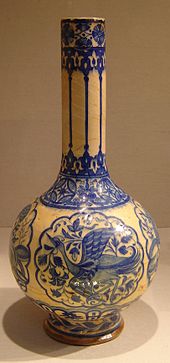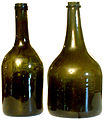Bottle
This article needs additional citations for verification. (November 2023) |


A bottle is a narrow-necked
Etymology
First attested in 14th century. From the English word bottle derives from an
Types
Glass
Wine
The
There are many sizes and shapes of bottles used for wine. Some of the known shapes:
- "Bordeaux": This bottle is roughly straight sided with a curved "shoulder" that is useful for catching sediment and is also the easiest to stack. Traditionally used in Bordeaux but now worldwide, this is probably the most common type.
- "Burgundy": Traditionally used in Burgundy, this has sides that taper down about 2/3 of the height to a short cylindrical section, and does not have a shoulder.
- "Champagne": Traditionally used for Champagne, it is similar to a Burgundy bottle, but with a wider base and heavier construction to withstand the pressure from the carbonation of the sparkling wine.
Codd-neck

In 1872, British
Soon after its introduction, the bottle became extremely popular with the soft drink and brewing industries, mainly in Europe, Asia and Australasia, though some alcohol drinkers disdained the use of the bottle. One etymology of the term codswallop originates from beer sold in Codd bottles, though this is generally dismissed as a folk etymology.[4]
The bottles were regularly produced for many decades, but gradually declined in usage. Since children smashed the bottles to retrieve the marbles, they are relatively scarce and have become
Plastic
This section needs expansion. You can help by adding to it. (October 2015) |
The plastic is strain oriented in the stretch
Aluminium
An aluminium bottle is a bottle made of aluminium (or aluminum, outside of British English). In some countries, it is also called a "bottlecan". It usually holds beer, soft drinks or wine.
Hot water
A hot water bottle is a bottle filled with hot water used to provide warmth. It can be made from various materials, most commonly rubber, but has historically been made from harder materials such as metal, glass, earthenware, or wood.
Gallery
-
A PET bottle
-
Stone ware jar for carrying water
-
A bioplastic shampoo bottle made of PLA-blend bio-flex
-
A contemporary metal bottle (Sigg)
-
Chinese ding-ware porcelain bottle with iron-tinted pigment under a transparent colorless glaze, 11th century,Song Dynasty
-
Normflasche bottle
-
Reusable glass milk bottle
-
Pontiled soda or beer "blobtop" bottle, circa 1855
-
Bocksbeutel bottle
-
Two bottles for Maas wine, called "thieves", 18th century
-
Blue glass bottle, 18th–19th-century Iran
-
Aluminium spray bottle
-
Empty beer bottles of different colors
-
Two modern hot water bottles shown with their stoppers
-
Plastic bottle of milk. One US gallon
Miscellany
Bottles are often
See also
- Beer bottle
- Bottle sling
- Bottle wall
- Bottling company
- Bottling (concert abuse)
- Butylka - The largest building in the world in the shape of a bottle
- Carinate
- Glass production
- Helmholtz resonance
- Klein bottle
- List of bottle types, brands and companies
- List of bottling companies
- Reuse of bottles
- Speyer wine bottle
Notes
- ISBN 978-1-930268-27-2.
- ^ Bottle, Online Etymology Dictionary
- ^ βοῦττις, Henry George Liddell, Robert Scott, A Greek-English Lexicon, on Perseus
- ^ "UK word origins". Archived from the original on 2008-09-13. Retrieved 2008-03-02.
- ^ Pisharoty, Sangeeta Barooah (19 April 2013). "Banter about Banta". The Hindu. Retrieved 27 May 2018.
References
- Soroka, W, "Fundamentals of Packaging Technology", IoPP, 2002, ISBN 1-930268-25-4
- Yam, K. L., "Encyclopedia of Packaging Technology", John Wiley & Sons, 2009, ISBN 978-0-470-08704-6
External links
 Media related to Bottles at Wikimedia Commons
Media related to Bottles at Wikimedia Commons
















